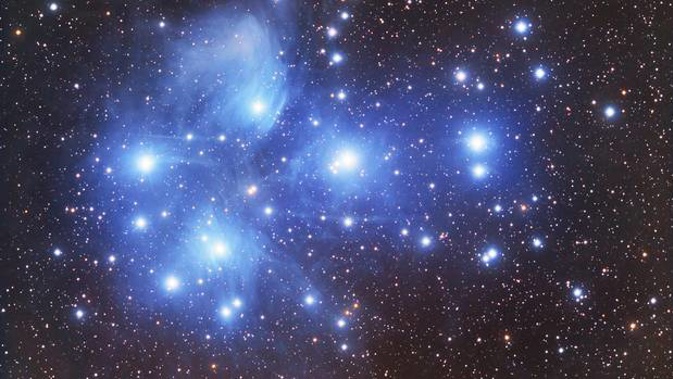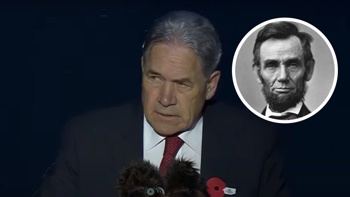
The appearance of star cluster Matariki amid our mid-winter sky means it's soon time to celebrate the start of the Māori new year. Since its revival at the turn of the millennium, Matariki has brought Kiwis together and taught us more our country's rich cultural heritage. Acclaimed Waikato University astronomer Dr Rangi Matamua thinks it's time to make it an official holiday. He talked to science reporter Jamie Morton.
What do you think Matariki means to New Zealand in 2018?
I think Matariki is a growing part of our national culture and identity - in many respects, it reflects a coming-of-age as a people.
We are embracing our diversity and Māori culture is becoming more visible, and a part of who were are.
Matariki sits in a really unique space because it's a Māori celebration that talks about unity, coming together and celebration, and that's something that all cultures can relate to.
And what did it mean to you, as you were growing up?
A manuscript containing 400 pages of traditional Tuhoe star lore was given to my grandfather by his grandfather, and most of my knowledge comes from that and other research I've done.
When I grew up, I came to understand that Matariki was a time of togetherness and celebration.
But one of the first things I learned from my grandfather early on, and which I still maintain, is the importance of remembering those who have parted with us since the last rising of Matariki.
How encouraging is it to see other cultures celebrating it?
I think there is a real passion and hunger for it.
I've been doing a number of speaking engagements around the country and this year I've noticed the crowds are bigger, and the interest is more often than not from non-Māori.
The beautiful thing about Māori astronomy is that, like most astronomical cultures around the world, it's a melting together of indigenous astronomy.
That's not just the science around the rising and setting of different celestial features, but also how it's embedded in ceremonies, practices and language.
It speaks of our spirituality and connectness to the environment - to our oceans and forests - and things that are greater than us as physical human beings.
This awareness is growing and I'm going to keep pushing to establish an institute for Māori astronomy, so we can begin instruction of a new generation of Māori astronomers.
/arc-anglerfish-syd-prod-nzme.s3.amazonaws.com/public/ONW5MJZH7JEBLP64VIDSHHAKYQ.jpg)
Traditionally, Matariki was a time for remembering the dead, and celebrating new life. In the 21st century, observing Matariki has become popular again. (Photo / Richard Leonard / Auckland Council)
Different iwi mark Matariki at different times but you've argued we often celebrate it prematurely. Why is that?
Māori follow what's called a lunar-stellar calendar.
And what we are trying to do is reconcile the Matariki dates with our Gregorian western calendar, or solar calendar.
The fact is that Māori didn't just wait for the first day that Matariki can be viewed - they aligned it with the most prosperous time of the lunar calendar.
Matariki is visible at the moment, early in the morning, but the lunar phase is not in the correct stage and won't be until the period from July 6-9.
Our dates change every year, due to the 11-day difference between the lunar and solar calendar.
So while most people are celebrating it - and good on them - the research that I have done and the knowledge base I hold tells me that we are usually far too early.
In fact, most of the time we're celebrating it, it's not even visible.
There have been suggestions we should ditch Queen's Birthday Weekend and make a new holiday for Matariki. What's your view on that?
I don't know about replacing it, because maybe that might offend a few people.
But some of the things we celebrate today - Queen's Birthday, Labour Day, Halloween - don't really have an association with who we are in the world.
Matariki is an event that's about coming together, feasting, family, remembering the ones who have gone before, and celebrating the future.
Could there be a better purpose?
It's a fantastic event and has relevance because it comes from Aotearoa and it's part of who we are.
As it becomes more a part of our national identity, bigger moves will happen to enshrine it within our culture - hopefully with a holiday.
Dr Rangi Matamua will speak at next month's New Zealand International Science Festival in Dunedin. For more information, or to book tickets, visit the website.
/arc-anglerfish-syd-prod-nzme.s3.amazonaws.com/public/7FQ7Q7FNNRC5RGZXDOXEJCXOVM.jpg)
"It's a fantastic event and has relevance because it comes from Aotearoa and it's part of who we are," Rangi Matamua says. (Photo / Richard Leonard, Auckland Council)
Our winter celebration
- Matariki is the Māori name for the cluster of stars also known as the Pleiades that rises in mid-winter, and literally means the "eyes of god" (mata ariki) or "little eyes'" (mata riki). According to myth, when Ranginui, the sky father, and Papatūānuku, the earth mother, were separated by their children, the god of the winds, Tāwhirimātea, became so angry that he tore out his eyes and threw them into the heavens.
- Traditionally, it was a time for remembering the dead, and celebrating new life. In the 21st century, observing Matariki has become popular again. Kites, hot-air balloons and fireworks help mark the occasion. In the early 2000s Te Taura Whiri i te Reo Māori (Māori Language Commission), the Ministry of Education and the Museum of New Zealand Te Papa Tongarewa, became involved in the revival of Matariki celebrations.
- Different tribes celebrated Matariki at different times. To some tribes the new year in mid-winter was signalled by the dawn rising of Matariki (the Pleiades), while to others it was the rising of Puanga (Rigel in Orion). For many iwi the appearance of Puanga in the night sky signalled the start of winter. Puanga was said to be one of the parents of the climbing plant puawānanga.
- The Maramataka Māori (Māori Calendar) has closer to 355 days in its year cycle as opposed to 365 days in the Gregorian calendar which apparently follows the sun. Pipiri, the time of Matariki's rising in the early morning, does not match up with June. Additionally, just because Matariki is visible does not mean it is the right time to read the stars for what the year ahead will bring. Matariki must be read when the moon is in the right phase in Pipiri: when the moon is in Tangaroa at the end of its third quarter and into the last quarter. The celebrations take place after this.
- Source: Ministry for Culture and Heritage
Take your Radio, Podcasts and Music with you









